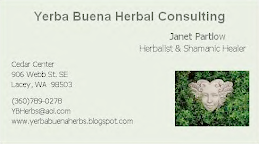 I haven't written in this healing blog for a few months. I think in part it's because we herbalists are like our plants: we go dormant in the winter. But as the days lengthen and the sun comes out, as we watch eagerly for the first signs of spring, as we see our beloved herbs breaking dormancy, we too come back to life and that green energy runs through us once again.
I haven't written in this healing blog for a few months. I think in part it's because we herbalists are like our plants: we go dormant in the winter. But as the days lengthen and the sun comes out, as we watch eagerly for the first signs of spring, as we see our beloved herbs breaking dormancy, we too come back to life and that green energy runs through us once again.I've been playing with vulnerary plants. Vulneraries are herbs that provide deep topical healing for skin. The word comes from the Latin vulnerarius which refers to a plaster or dressing for healing wounds. This is exactly what an herbal vulnerary does.
Typically you make an infused oil first, then blend your different plant oils together, then add beeswax to make a salve. (Check the blog on dandelion oil for infused oil instructions.) In this photo you can see the infused oil with beeswax, now cooling off and setting up. It's easy and fun to make!

My first foray into vulnerary salves was one summer day in July. I went to get my Herbal Ed's (a commercial version of a wound salve) and scoured the house, unable to find one. I was still a novice herbalist, so I gathered up my courage and marched outdoors to the backyard. I sent out a mental call to the plants that could help me with this purpose and was astounded by how many answered me. As I wandered around the yard, collecting the plants that presented themselves (and there were several), the thought came to me: all the vulneraries known to the Goddess. And that's how I developed my own herbal vulnerary salve.
I will pass on to you what I put in my salve recipe. There are some people might caution against this, saying this is proprietary information that should not be shared.

Herbalism is not like that. Herbalists know down to our bones that we all live in a village and we all have responsibility for each other. We have a deep understanding that all of us are born into this world of nature, with a relationship to plants that is ours by birthright. Herbal elders taught me what they know and in return, it is my commitment to pass what we learn on to the next generation.
So here is my recipe:

Make infused oil from as many of the herbs below as you wish. I recommend olive, almond or jojoba oil as the base. Many of the herbs can be found right in your own garden, but are also sold as bulk products in herb stores. Strain out the oils and use equal parts of each, putting into a double boiler, warming over low heat. For every two cups of oil, add 3-5 tablespoons of beeswax. Let the wax melt in the warm oil, then dip a metal spoon into the oil/wax solution and put in the freezer. Wait five minutes and test your sample: is it too firm or too runny, or just right? Add more oil or beeswax as needed. Pour while still warm into a clean jar with a good lid and let cool. Store in the frig for longer shelf life.

Herbs in Janet's Nine-Vulnerary Topical Healing Salve
=St. John's Wort: If I could only choose one herb, this would be the one. It is profoundly effective in healing wounds, soothing the itchies and offering pain relief for burns or other topical nerve pain. A good quality oil is a deep ruby red; look for this in oils you make or buy.
=Cottonwood: This would be my second choice. It is an excellent antibacterial, and its resins keep the salve from going rancid over time. It is also excellent for reducing pain.
=Comfrey: Another topic choice, it is a premier wound healer. It pulls wound edges together, and dramatically speeds up wound closure.
=Calendula: this is an excellent antifungal and antibacterial herb. Used early on scraped skin, it can help prevent an infection from getting established. More advanced infections may need a doctor's attention.
=Chickweed: this weed is often despised by gardeners, but herbalists know that it is full of nutritious, healing green medicine that soothes and moisturizes.
=Chamomile; there are two kinds of chamomile: German and Roman. I like both f
 or their anti-inflammatory, pain relief qualities. Both are easily grown in the garden.
or their anti-inflammatory, pain relief qualities. Both are easily grown in the garden.=Mullein: in the world of herbalists, there is a very old concept called the Doctrine of Signatures. Basically it means that often plants look like the things they do. So for example, mullein looks like a beautiful warm fuzzy healing green blanket. That's exactly what it does on skin.
=Helichrysum italicum: I've used this plant for years for its wonderful ability to relieve pain. It is also said to be very effective in reducing scars, but I haven't tried this yet.
=Plantain: another yard weed, this homely plant is a master at soothing inflamed, irritated tissues. It has long historical use as an on the spot remedy for nettle stings.
As always, this herbal preparation is not meant to replace medical care. Be sure to get any persistent skin issues diagnosed. Once diagnosed, herbs can then be used to supplement any treatment.
Janet
Resources:
•
Complete Illustrated Holistic Herbal by David Hoffman
• Many thanks to Glen my gardener, who helps me grow and harvest the herbs!



















